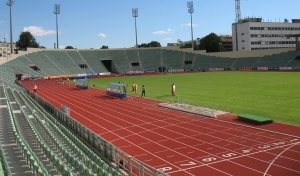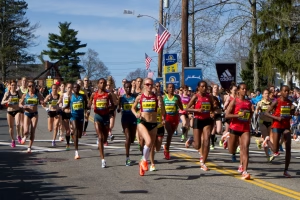Many endurance runners have a natural curiosity about VO2 max testing and wonder whether it is worth the hype. Physiological tests like this are usually conducted in a university exercise physiology lab, national Olympic training center, or some other elite athlete service center. If you are paying for it yourself, the test might cost a few hundred dollars. And the service is not usually well-advertised, which leads to a feeling of exclusivity around the whole thing.
But I think it’s great for runners to be interested in physiological testing. Everybody wants to have the best chance to succeed according to their potential. If I had the ability to provide everybody with elite-level sport science support, I would. The goal of Distance Running Lab is to educate and provide as much service as possible through this website and associated media. I am glad when runners of all levels put in the effort to learn about their own physiology and use that information to better their performance.
[Disclaimer] This article is about oxygen consumption related to distance running performance and not cardiovascular disease. If you are seeking information about oxygen consumption in the context of a medical condition, please contact a licensed medical professional.
1. What does VO2 max mean?
Let’s start with VO2 (without any “max”). VO2 is the rate of oxygen delivery to working muscles. There is a measurable VO2 when you are at rest and this can increase up to 20 times or more for the very fittest individuals.
During rest and exercise alike your lungs inhale air and take up the oxygen. This oxygen is delivered via the blood first to the heart and then it is pumped to the working muscles. The muscles then accept this oxygen and can use it to make energy via the oxygen-dependent metabolic processes.
More intense exercise uses up energy faster, so the rate of oxygen delivery increases too. You can feel this with increased breathing and a faster heart beat. Eventually the intensity becomes so much that the oxygen-delivery system reaches its maximum.
Exercise physiologists like to debate the reason for this limit – and whether there is a limiting factor in the lungs, heart, blood, blood vessels, muscle cells, or some combination of the above. More holistically-minded exercise scientists also remind us that the contribution of the brain and nervous system recruitment are also vastly important.
Whatever the reason for this limit, it is true that every individual has a maximum VO2 value that can be measured. Above your maximum oxygen consumption, energy needs require anaerobic metabolism, which means rapid fatigue. Since endurance running performance depends mostly on oxygen delivery, a higher VO2 max is better, all other things being equal. So, does it help to know your VO2 max? And how should you use that information?
2. What does VO2 max really tell you?
The question of how to use this information is an important one. Here are a few reasons that I think runners have for wanting their VO2 max tested:
- It will tell me my ultimate potential in running.
- It will tell me what I need to work on in my training.
- It will tell me how to set proper intensity training zones.
Let’s go through each of these.
Does VO2 max indicate distance running potential?
Short answer: yes and no.
If you take a large group of people across the population, the group will include people of all shapes and sizes, all levels of performance, and all levels of training experience. In such a group, the individuals with the highest VO2 max will be the best runners.
In other words, there will be a nice straight-line relationship: those with the lowest VO2 max will run the slowest and those with the highest VO2 max will run the fastest.
However, if you take a group of well-trained distance runners, you will no longer be able to separate the winners using VO2 max. There is a well-known study from the 1970s where elite distance runners from the United States were tested in a physiology lab.
This group included Steve Prefontaine (VO2 max ~84 ml/kg/min) and Frank Shorter (VO2 max ~71 ml/kg/min). Both Prefontaine and Shorter were Olympians, but Shorter’s VO2 max was 15% lower. If VO2 max were the only determinant of distance running success, Shorter would not even be in the same league.
So, in a group of similar runners, VO2 max will probably not distinguish the fastest from the slowest.
Will a VO2 max test identify areas for improvement?
Perhaps, but the benefit may be limited.
The goal of any sport science testing should always be to lead to actionable insights. In the case of aerobic fitness, even without a VO2 max test, we already know of the importance of aerobic fitness and training to improve it.
No matter whether you have a poor or excellent VO2 max, you are still going to train your aerobic system. And your training program will already be set up so that you train specific paces, according to your goal race distance.
For example, both 800 m runners and marathoners need to have a high VO2 max, but the principle of specificity suggests that the 800 m runners will spend more time at VO2 max pace than will marathoners, who must spend more time accumulating miles at the slightly slower speeds associated with anaerobic and lactate thresholds.
If you want to fully understand the best areas for improvement, see how your different race performances rate according to the method I demonstrate in this article. If your performances score lower at shorter or longer distances, then you might alter your training intensity emphasis to focus on these specific ranges.
Will knowing my VO2 max help me define my training zones?
Yes, but there may be a more convenient alternative.
The thinking is that VO2 max is important and the best way to train it is to run at that pace, therefore you need to know your VO2 max. It’s true that training zones can be nicely defined by different percentages of VO2 max. If you take this approach, I am confident that you will be training at the proper mix of intensities – sometimes at your aerobic maximum, sometimes at lower percentages during recovery runs.
But you are training for a good race, not a physiological test. Since that is the case, I recommend that you view your training zones relative to race pace instead of a physiological metric. This approach uses a table like the one below. NOTE – it is not possible to precisely state the different zones for any individuals. These are approximations, and you won’t get this information from a lab test unless you first conducted a VO2 max test and then another test of how long you can run at different percentages of VO2 max.
| Race distance | Example time | Approximate % VO2 max |
| 3000 m | 9:00 | 100 |
| 5000 m | 15:50 | 95 |
| 10,000 m | 33:20 | 90 |
| Half marathon | 1:13:50 | 85 |
| Marathon | 2:34:43 | 80 |
The example table above is based on a study by sport scientists in Portugal, in which the participants had an average 3000 m time trial of 9:03. They were thus able to run at about 100% of their VO2 max pace for about 9 minutes.
Notice that I emphasized the word pace. I did this because I don’t want to suggest that their physiology was working at 100% VO2 max for that whole 9 minutes. It takes a bit of time to accelerate oxygen consumption, so the first few minutes would be at a lower percentage of that max. You can run at the pace for the whole time. But you can’t run at that physiological intensity the whole time.
The duration different individuals can run at each percentage VO2 max is not always the same. Some runners might last a few more minutes than others at the same physiological intensity. Keep in mind also that if a runner underperforms on a VO2 max test (i.e., quits early), the reported maximum will be lower and the time lasted at each intensity might be longer (because it’s easier).
Even when conducted at a laboratory, the imprecision and nuances of a VO2 max test means that any recommendations that come from that test are only approximate. It doesn’t mean that they are wrong, only that it may mean that other methods may provide a similar benefit.
It’s good to want to improve your aerobic physiology because that is how you will eventually run faster. I think that you can ensure the proper mix of intensities by employing a multi-pace system based on the different race distances. But for those who wish more formal guidance, a VO2 max test can provide that.
3. Does my running watch measure VO2 max?
No, your running watch cannot measure your oxygen consumption. I would love for that to be the case, but measurement of oxygen consumption requires you to breathe through a mask or mouthpiece. The device measures the oxygen going in and out when you breathe and the difference between in and out is what your body has used.
A running watch predicts VO2 max based on information it does have – heart rate and running speed. Those data are put into a prediction equation to estimate your VO2 max. These prediction equations are created by testing many people and comparing the watch data to actual VO2 data collected in a laboratory.
4. The laboratory VO2 max test
Where to get it
Unless you are in a national program for elite sport, a VO2 max test will most likely be conducted at a university exercise physiology laboratory or medical system that offers sports performance services.
You can try searching for the following departments that might exist at a local university: “sport science”, “exercise science”, “exercise physiology”, “human kinetics”. To search for services offered in a medical system, just search for the name of your local hospital and “sports performance”.
Preparing for a VO2 max test
First, the test needs to be a running test, as a VO2 max can be measured for many endurance sports such as cycling. While there are aspects of cardiovascular fitness common to all modes of exercise, it is crucial that your test is a running test.
The simplest reason is that you need to know how to push yourself in the exercise you are performing. You will not be able to give your best cardiovascular effort during cycling if you primarily run.
When you arrive for your test, you will probably complete some forms regarding your medical history and sign a liability release. If you have any cardiovascular condition, but are still cleared for exercise and do it regularly, the staff will definitely want to see that documentation from your doctor.
Some labs will require you to fast overnight and avoid caffeine prior to the test. The reason is that ingestion of different proportions of carbohydrates, fats, and caffeine can alter metabolism. Although this is true, I don’t agree that this should be a requirement. Overnight fasting may not represent normal habits, and if not, you would be doing the test in a way that is unnatural to you. If you enroll for a VO2 max test as part of participation in a formal research study, however, any nutritional pre-test controls won’t be negotiable.
You want to be able to give your best effort, so treat your preparation like a race. Avoid fatiguing training in the day(s) before the test and sleep and eat as you normally would.
One criticism I have about testing is that the time and space for a full warmup is usually not provided. You will definitely be provided the opportunity to warm up on the treadmill prior to the beginning of the test, but you probably won’t be able to duplicate everything you commonly do on the track or trail. You might ask if you may warm up on your own outside if it is convenient.
One last aspect to prepare for is that you be very comfortable with strenuous running on a treadmill. The test requires you to run until you can’t continue. If you are worried about falling off the treadmill at high speeds (while wearing a breathing mask), you will most likely stop before you have truly given your maximum effort. This is crucial because I believe many people underperform simply because they are not used to the testing environment.
What happens during a VO2 max test?
A VO2 max test is an incremental test which means that it starts slow and increases the intensity at regular intervals. There are many protocols for how the increases take place. You should ask your testing staff what protocol they use.
For running, the protocol should increase speed only and not the incline. If the incline increases, the most strenuous part of the test will be done with a significant uphill, which doesn’t allow for a normal assessment of running speeds, heart rates, etc. Perhaps the treadmill will be kept at a 1% incline to counteract the absence of wind resistance with treadmill running.
The protocol I favor is the one used in this scientific paper (Noakes et al., 1990). It starts at 12 km/h (7.5 mph or 8 minute mile) and increases by 0.5 km/h every 30 seconds until you can’t continue. The idea is that you will continue for several minutes at least, so if you are a slower runner and the starting speed is too close to your max, you might start the test at 10 km/h or 8 km/h instead.
There are other protocols that may have longer intervals like 1 minute long, and protocols where the speed might increase in increments of 1 km/h.
The testing staff will encourage you to give your best (probably by yelling!). They will remind you to safely hold on to the treadmill when you are done and will help you remove the breathing mask or mouthpiece. This will be a messy time because of accumulated saliva!
5. How is a VO2 max test analyzed?
The measurement device monitors several physiological variables at once:
- The oxygen you consume
- The carbon dioxide you produce
- Your heart rate
- Your running speed
From these variables, the staff will be able to report your maximal oxygen consumption. This will typically be in the last stage you complete. You might continue running a few stages past that and demonstrate a plateau in VO2, but not everybody shows that.
The staff may also provide your anaerobic threshold, which is an intensity lower than VO2 max. Anaerobic threshold is a catch-all term associated with rapid increases in breathing and blood lactate variables. The existence of a precise threshold is debated in the scientific literature, but the concept associated with sub-maximal aerobic fitness is sound. You also want this to occur at a relatively high running speed and a relatively high percentage of VO2 max. It correlates to performance at the longer distance like half marathon and marathon.
I actually don’t recommend seeking a measurement of anaerobic threshold as part of a VO2 max test. The test becomes too long if you search for both anaerobic threshold and VO2 max. I think anaerobic threshold testing should have a standalone protocol with longer stages to allow for as precise an identification as possible. When the test is too long, you impair your ability to perform well at the highest VO2 stages – you will be too tired by then.
6. How to train VO2 max
It is possible to improve your VO2 max, VO2 max pace, and the duration you can maintain that speed. It is generally accepted that the best stimulus to improve VO2 max is running at about that pace.
In the example above, the runners were able to run at about their VO2 max pace for about 9 minutes. Interval training splits up the distance, which lessens the strain and makes it possible to still accumulate a lengthy time spent at VO2 max.
Here is one method by French researcher Veronique Billat to accumulate time at VO2 max using very short intervals according to time:
- Option 1: 15 seconds @ 90% VO2 max pace alternating with 80% VO2 max pace.
- Option 2: 15 seconds @ 100% VO2 max pace alternating with 70% VO2 max pace.
A total accumulated distance (including fast and slow) might be 4000-5000 m. Workouts like this that involve very short intervals can maximize the time you spend at VO2 max (the physiology, not the speed). With longer intervals, there might be an inefficient use of time as your engine speeds up and slows down with every interval.
Remember, however, that even though it is good to consider how much time you are spending in a physiological zone, when you are running at a certain speed, your are still in a specific biomechanical zone, meaning that your leg muscles are still propelling and landing as part of your running gait. That neuromuscular action is also something that needs to be trained.
With this perspective, one considers all the benefits from an interval session, not just the oxygen-related ones. One possible workout that might emphasize the pace more than the physiological intensity is:
- 16 * 400 m @ 3000 m race pace with 45 seconds rest
The above allows for the accumulation of 4800 m of running at that pace. The distance is more than 3000 m, but the intervals are relatively short. It is thus much easier than:
- 8 * 800 m @ 3000 m race pace with 60-90 seconds rest
The first workout (16 reps) is easier because each interval has a relatively easy portion at the beginning. This occurs only half as often when doing 8 reps only. The latter workout would “hurt” more near the end of each interval, which can be desirable when attempting to simulate the challenge of an actual 3000 m race.
You can also try interval lengths of up to 5 minutes or so (perhaps 3 reps), and the distance will vary with your own running speed. This would emphasize the red-hot intensity of a 3000 or 5000 m race. This workout would be very stressful, so you would need to be in good shape.
Over the course of a season, you might emphasize the physiological zone first and then maintain the physiology while you train the race pace per se as race-ready sharpening occurs.
7. Other ways to improve: VO2 max and body weight
For running, VO2 max is properly expressed per kilogram of body weight. This is because running is a weight-bearing activity, in contrast to cycling. For every kilogram of body fat lost in a healthy manner, and maintenance of cardiovascular function, VO2 max will automatically increase. For example, with a 5 kg fat loss:
- Before: VO2 max = 40 ml/kg/min @ 70 kg
- After: VO2 max = 43 ml/kg/min @ 65 kg
This will result in an increase in performance, all other things being equal. But don’t make the mistake of thinking that mere weight loss improves your cardiovascular fitness. Rather, the benefit occurs because the same cardiovascular function now can carry a lighter individual.
Summary
VO2 max is a popular point of discussion by runners interested in exercise physiology and peak performance. It is definitely part of what makes a good distance runner, but its predictive value is not great in a group of similar runners. If you want a well-balanced training plan, run at high percentages of your VO2 max, along with easy days for recovery. For the most part, your training zones can be estimated from your pace in the different race distances.
This is a good approach because you are most likely most interested in a good race time instead of high physiological values! By doing this, your cardiovascular system will be challenged and your running-specific neuromuscular action will also be trained. Remember that peak performance is achieved when all systems work optimally!




